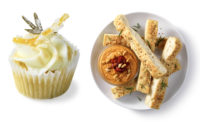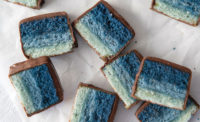Taste remains a key driver in consumer food purchases. According to the 2018 IFIC “Food and Health Survey,” taste was rated the No. 1 factor, with 81 percent of consumers stating taste impacts their decisions. Consumers still seek nostalgic, familiar flavors—but also flavors that appeal to their adventurous side.
“As millennials continue to drive a lot of the innovation behind new flavor launches, palates are becoming worldlier,” says Victoria Ward, senior marketing manager, IFF, Philadelphia. “Expect a continued rise in globally inspired flavors trending towards bold, exotic and gourmet.” She cites date, fig, matcha green tea and ginger flavors as trending across sweet goods. “Savory-forward flavors are also active in the category, led by salt, heat and spices mingling with traditionally sweet flavor profiles for added dimension and complexity. Salted butter cookies, sweet heat potato chips and chai spice cashews exemplify this trend.”
Elevated classics, childhood favorites spun in an adult direction and sophisticated dessert profiles are also trending, notes Philip Caputo, marketing and consumer insights manager, Virginia Dare, Brooklyn, NY. “These on-trend categories appease cautious and adventurous consumers alike.” He points toward “elevated classics,” merging vanilla, cocoa, caramel, maple, banana and other favorites with sophisticated pairings to create new flavor experiences, like vanilla tarragon blueberry, maple curry spice, vanilla anise and mint, and cocoa cardamom.
Caputo also predicts banana will be a star flavor, suggesting concepts like upscale banana breads, incarnations of bananas foster, banana custard hybrids and British banoffee pie, which combines banana with toffee. He also points toward “the fire treatments,” like caramelized, burnt, grilled, brown buttered and flambé.
Spinning childhood classics into new directions is also on-trend. “Adultified childhood favorites combine childhood and adult flavors for bakery applications,” suggests Caputo, suggesting cream liquored birthday cake or toasted cornflake cereal French toast with bourbon maple glaze.
Herbal, floral and botanical
Interest in healthier eating has spurred consumption of plant-based products. According to a recent report from Technavio, the global floral flavor market is predicted to grow at a CAGR of almost 10 percent from 2018–2022, with potential health benefits of florals as a contributing factor to growth.
Kayla Blanding, applications technologist, Synergy Flavors, Wauconda, IL, shares some top flavor trends:
- Herbal/floral—lavender, rosemary, chamomile and hibiscus are associated with a “natural halo” and pair well with fruits like citrus and sweets
- Exotic/ethnic—yuzu, dragonfruit and açaí are expanding into new product categories as cultural influences and interest in diverse, exotic flavors increases
- Sweet browns—molasses and honey are familiar sweeteners with appealing, unique flavor profiles, conveying warmth, nostalgia and feelings of “homemade goodness”
Synergy Flavors recently launched its TRU Stories platform, featuring clean-label, natural extracts and certified-organic flavors with pure flavor profiles, including citrus, herbs, spices, florals and botanicals. “Synergy has identified lavender, yuzu and molasses as flavors that will inspire innovation in the new year,” says Blanding. “For bakery specifically, we see a constant need for sweet brown flavors to add that sense of indulgence and sweetness—thus calling out molasses as a potential leader in this segment. Our applications team created molasses-filled sandwich cookies, showcasing a true-to-nature molasses flavor profile. To do so, our flavor experts created a natural blackstrap molasses bakers emulsion, using Synergy Pure molasses essence as a top note.” Other applications created to showcase the new line of flavors include: lavender rosemary shortbread, honeysuckle hibiscus lemon bars and yuzu Turkish delight.
Flavorchem, Downers Grove, IL, has developed a line of flavors called Nature’s Best Combinations. “Nature’s Best Combinations are those botanical flavors that come from nature, creating an organic taste that is true to the plants, florals, herbs and roots from which they are derived. Satisfying the millennials’ adventurous palates and clean-label criteria, the trend will be to create unique botanical flavor combinations,” suggests Anu Fisher, marketing analyst. She cites examples like the new 365 Everyday Value Lemon Lavender Shortbread Cookies from Whole Foods and Simple Truth Fig & Thyme Crisp Crackers from Kroger.
Ensuring consistent supply can also pose challenges. Flavorchem’s new natural vanilla replacer is resonating with its customers, notes Fisher. “Flavorchem’s natural vanilla replacer contains real vanilla, providing an authentic flavor, yet offering supply stability, cost-reduction and consistent quality over pure vanilla extract.”
Peggy Castaldi, director of marketing, SupHerb Farms, Turlock, CA, says herbs have been trending of late. In 2018, it was mint, and in 2019, sage and rosemary are trending, she notes. “Breads and other baked goods are great carriers for flavor and can provide new experiences. There are numerous international baked goods that act as carriers for trending handheld, on-the-go snacks. Bread bakers can stay up-to-date by incorporating the latest trending herbs into their breads and other baked goods and snacks.”
Castaldi sees savory desserts trending. “Savory desserts are popular in the rest of the world. This trend is finally coming to the U.S.—for example, chocolate cupcakes with lemongrass frosting or a peach and ginger scone.” She suggests SupHerb Farms Fusions Aji Pesto for a unique twist in soufflés, or Ancho Chile for cornbread. “Savory trending flavors can be incorporated into any baked good to provide an ethnic twist in a familiar format.”
Consumers are seeking new, bold, global flavors, notes Jill Puckett, market development specialist, Kalsec, Kalamazoo, MI. “Currently in snacks we are seeing more brands turn to unique flavors that sound complex and premium to consumers. Complex flavors include flavor combinations that are new to the palate, while premium flavors have something extra, above and beyond what is expected. Trending complex flavors include global favorites like pesto, kimchi, gochujang and curry. Premium flavors often speak more to the process and include techniques such as roasted and toasted, as well as ingredients like avocado, turmeric or beer flavors.”
Most recently, Kalsec has launched new beer-style flavors including porter, IPA, wheat and lemon shandy. These flavors are best suited for snack mixes, flavored pretzels and nuts. The company has also introduced North African and Middle Eastern flavors, including harissa, za’atar and berbere, as well as roasted spices like cumin, coriander and cardamom. These flavors can be used on nuts, pita chips and a variety of different snacks.
Taste modulation
Many brands are improving the nutritional profile of their products by adding protein, fiber or reducing the amount of added sugar or salt—formulation changes that can impart off-flavors. Sensient Flavors, Hoffman Estates, IL, offers its Taste Modulation brand to naturally mask such notes. “The Taste Modulation portfolio uses extraction capability to recover specific functional materials, our skilled creation and application expertise and the evolving science of taste perception and receptors,” says Keera Perumbala, marketing associate, sweet flavors. “These not only can be tailored to specific label needs of our customers, but also tailored to work with their specific products. We have supported a number of customers in their product conversion journey from artificial flavors and colors to natural, clean versions.” She notes these natural products perform effectively in baked goods, offering a vivid finish with fresh flavors.
“There are some flavor materials that bond with receptor sites to block certain undesirable perceptions,” says Blanding. “However, most masking flavors are generally used to ‘fool the senses,’ to distract the consumer from the actual off-note. With our library of dry and liquid flavor solutions, Synergy Flavors can mask a variety of different off-flavors in baked goods and snacks, such as protein-fortified baked goods, sugar-reduced products that contain natural or artificial sweeteners, and other sources of bitterness.”
Visual appeal
The first impression formed about a product is often based on visual appeal. “We have some beet-based products that can impart pink-purple colors to various baked products,” says Deepti Dabas, principal scientist, Kalsec. “These highly stable, beet-based colorants can survive the heat processing of baking to create attractive pink and purple crackers, cakes, biscuits, breads, muffins or brownies. Turmeric, paprika and beet colors can make excellent choices for yellow, orange and purple hues, respectively. Various combinations of these colors can even lead to an attractive red hue.”
When imparting color to snack applications, in some cases, the color is best applied to the coating, depending upon pigment characteristics, desired functionality and appearance of the snack, notes Dabas. “For special applications like pie fillings, colored chocolate, glazes and frostings, we have suitable anthocyanin-based colors which not only survive the harsh baking conditions, but also provide an attractive red-purple hue to the product.”
Sensient offers a rainbow of bake-stable colors from natural sources. “Some notable options would be SupraRed, which filled an unmet industry need for a bake/extrusion-stable natural red; Pure-S paprika, which provides bright oranges without any off-notes; Sienna natural brown fruit juice if manufacturers are seeking alternatives to caramel colors; a very unique indigo blue from a vegetable juice; and some exciting new green and dark-brown options that were recently launched,” shares Perumbala. The colors noted have all been effectively used in bakery applications, including muffins, bagels, cookies and croissants.
Flavorchem recently introduced a caramel color replacer. “The caramel color replacer is made from natural botanical extracts and delivers a comparable hue to traditiona l caramel color, eliminating the need for a Prop 65 label in the state of California,” notes Fisher.
Some ingredients, such as those derived from sweet potatoes, can add a trifecta of benefits—flavor, appearance and nutrition. “With fiber, beta-carotene and other nutritive advantages, our sweet potato ingredients support efforts at improving nutritional profiles of snacks and baked goods, while retaining great taste and appearance,” suggests Paul Verderber, senior vice president of sales, Carolina Innovative Food Ingredients, Nashville, NC. For instance, Carolina Craft dehydrated sweet potato granules can work as a topping or inclusion in breads or other baked goods, adding nutrition, a natural amber hue and a pleasant sweet potato flavor—and it simplifies the ingredient statement, something that’s always in demand these days.





